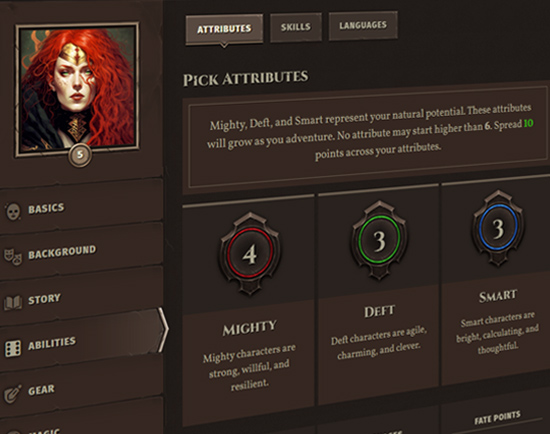You are uniquely empowered as the GM to advance the narrative in ways the players are not.
Let's take a closer look at the conversation and what's happening when you say something happens vs. when the players say something happens in the game.
Declaration vs. Narration
When you say something and when you remain silent both have meaning in the game.
By narrating what happens in response to what the players declare their PCs do, you update the state of the fiction and thereby advance the narrative. Only you can do this as the GM: the players can make similar declarations of intent, but what they say is not narration, therefore it doesn't advance the narrative.
Example of Declaration vs. Narration
For example, the player might declare that their PC picks up his sword after being knocked prone, leaps across the chasm to grab the rope, swings into the action, and seizes the artifact from the BBEG's pedestal. If your response as the GM is "make a spell check to resist the electrical curse on the pedestal," you've implicitly narrated that all the things the player declared have happened from point A (getting up from being knocked prone) to point B (seizing the artifact), and without a chance of failure on their part. It may be that you decided there was no meaningful choices to be had along the way, but either way, you've turned their declaration into a reality within the fiction.
Look for Failure Points
If you don't agree that the player can achieve all the things they declare without a chance of failure, you have to intervene at the first opportunity for failure ("I leap across the chasm to grab the rope") and then call for a roll. In this example above, the GM would simply backtrack to that first declaration that has a meaningful chance of failure, and then start the resolution process.
Facilitating Immersion
In setting the scene, we've discuss the magic number 3 when it comes to the limits of players' active memory, and how we can add additional detail to the scene as players interrogate it. We also talked about, whenever possible, drawing on the five senses when narrating (what do they hear? what does it smell like? what does it feel like?), and using music and imagery to enhance narration.
Be mindful of your cadence, word choice, and pacing when narrating. Slow, deliberate phrasing with pregnant pauses lends itself well to suspense and horror, whereas a speedy back and forth with players coupled with dramatic gesticulation on your part works well for action-packed scenes.
Reinforcing the Status Quo
When it comes to narration, however, it never hurts to re-state the obvious, even between player declarations. Your goal with reiterating is to ensure that everyone at the table has the same imagining of the scene in their minds as they make decisions for their PCs. In many ways, your narration is the "glue" that makes the fiction cohesive.
Example in Play
When you’re rotating the spotlight, you may find that some players need a beat to collect their thoughts and contemplate their action before communicating that to you. You’ll know which players are ready to go the second you call on them, and which need more time. One technique you can use to buy the thinkers time is to reiterate the status quo of the fiction while they’re thinking. This is especially useful in encounters, where the fiction is constantly changing.
GM: All right Absallah, what do you do?
Realizing that Absallah’s player needs a moment to contemplate her action, the GM immediately reiterates the status quo:
GM: You hear the door slam shut as the guard you trick goes outside to investigate. There’s now only one guard sitting at the playing table, mumbling to himself about how much he hates his colleague. The room is dark except for a lantern sitting on the corner of a wooden desk.
Absallah: Okay, I’d like to use telekinesis to push that lantern off the edge of the desk!
GM: Great. Since you’re hidden and he’s unaware of you, he doesn’t see the furtive hand movements you make to kick off the spell…
On Fictional Positioning
This is discussed in some detail in the core rules under the law of the fiction, but it's worth reiterating here that the rules as written can't override the position of the fiction. For the rules as written to be able to be applied by the GM in a resolution, the fiction needs to first make it possible.
For example, a spell like Basilisk Gaze requires a victim to meet the spellcaster's gaze in order to be transmogrified: if the victim doesn't have eyes or is blind, then the spell can't affect them. This may seem obvious, but it's a reminder that the common sense reality of the fiction is what makes the rules as written possible...
There Are No Rules as Written
…Which leads us to an even more philosophical understanding of the rules of written: that they don't actually exist.
Or at least, they have no power in a vacuum.
Every time you invoke a mechanic to yield a resolution, you have to invoke it in the context of a unique situation, and that requires your interpretation added to the consensus understanding of the fiction up until that point. Therefore, when players make an appeal to "the rules as written" without considering the context in which the rule will be used, the position of the fiction will always prevail over how something was worded in the rulebook.
Rolling in the Open
It may seem odd to have this topic under narrating the fiction, but the narrative the dice imply are often just as important as what you narrate as the GM.
In OSR+, you are encouraged to roll in the open. Let players see the result of the dice as they fall. Not only does this keep you accountable to the rules, but it builds trust with the table because the players will see that you're just as beholden to the dice as they are. Rolling in the open also heightens the stakes of play: when you roll a critical failure, players rejoice, but when you roll a critical success, they squirm.
On the Visibility of Mechanics
Just because players can see the dice doesn't mean they're entitled to know anything about the mechanics you're playing by.
NPC stats should remain GM-facing. Only if the PC has used an ability or interrogated the fiction in such a way that a mechanic could be revealed should you volunteer information about an NPC's stats.
Examples of Revealing NPC Stats
For example, a PC might take the time to read the aura of magic surrounding an NPC's spell to determine exactly what spell it is. Similarly, they might ask you how bad the enemy looks in an encounter, in which case it's OK to volunteer that he's on his last leg, or his armor looks broken. The key is to avoid naming the mechanics directly, and instead communicate what you can from the perspectives of the PCs.
When to Reveal TNs
This one is simple: always reveal the TN!
There's no need to hide the target number from a player, especially when players are required to add story tags to the roll before they roll the dice. In a contested roll, also be sure to declare your result before the player rolls, so they can factor in any optional benefits before rolling the dice.
 Archetypes
Archetypes Armor
Armor Classes
Classes Conflicts
Conflicts Cultures
Cultures Ethos
Ethos Flaws
Flaws Glossary
Glossary Kits
Kits Maleficence
Maleficence Origins
Origins Shields
Shields Skills
Skills Spells
Spells Stances
Stances Status Effects
Status Effects Tactics
Tactics Talents
Talents Techniques
Techniques Treasure
Treasure Weapons
Weapons











 Hall of Heroes
Hall of Heroes Hall of Legends
Hall of Legends



 Dungeons & Flagons
Dungeons & Flagons